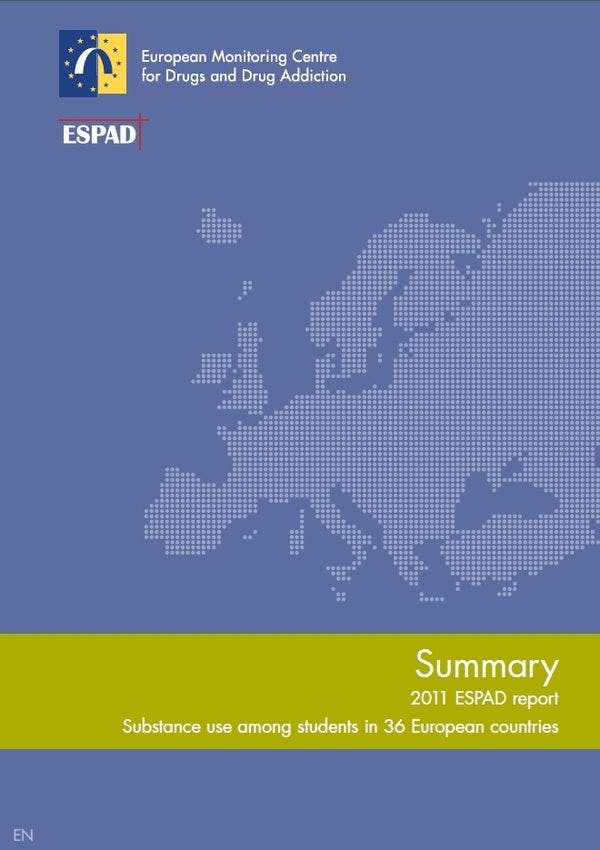Proyecto europeo de encuestas escolares sobre el alcohol y otras drogas 2011
Este nuevo estudio del Proyecto europeo de encuestas escolares sobre el alcohol y otras drogas (ESPAD) muestra unos niveles generales estables de consumo de drogas entre los escolares y una reducción del ‘consumo esporádico excesivo de alcohol’, pero no una disminución del consumo de cigarrillos. Más información, en inglés, está disponible abajo.
Suscríbase a las Alertas mensuales del IDPC para recibir información sobre cuestiones relacionadas con políticas sobre drogas.
________________________________________________________________________
Overall, the use of illicit drugs among 15–16-year-old school students appears to have stabilised, according to the latest European study of this group published today by the European school survey project on alcohol and other drugs (ESPAD). The report, based on a 2011 survey in 36 European countries, also reveals a reduction in ‘heavy episodic drinking’ (five drinks or more per occasion). But the survey highlights country differences and the need for vigilance where cannabis, inhalant and tobacco use has been seen to rise.
This is the fifth data-collection wave conducted by the ESPAD project, with multi-national surveys carried out every four years since 1995 (1). Over 100,000 school students took part in the latest survey. Of the countries participating, 23 were EU Member States. The 2011 ESPAD report: substance use among students in 36 European countries, available in English, will be complemented by a multilingual summary produced with the support of the EU drugs agency (EMCDDA) (2). The EMCDDA includes ESPAD data in its annual reporting on the drug situation and the two bodies work closely together under a cooperation agreement signed in 2007 (3). This cooperation was scaled up in 2011, with the partners vowing to boost joint work and technical cooperation to enhance understanding of long-term drug use trends among this population in Europe.
The new survey results show that the increase seen in the use of illicit drugs among this age group in ESPAD countries between 1995 and 2003 has since stalled, with the average prevalence remaining unchanged at 18 % between 2007 and 2011 (11 % in 1995; 20 % in 2003). The vast majority of the students surveyed in 2011 who had ever tried an illicit drug, had used cannabis. Average lifetime cannabis use was reported by 17 % of the students (4), use in the last 12 months was reported by 13 % and use in the last 30 days by 7 % (all unchanged overall). But despite this overall stable picture, the proportion of stu¬dents who had ever tried cannabis increased significantly between 2007 and 2011 in 11 of the 36 ESPAD countries (and fell in five).
The 2011 ESPAD data show that over three-quarters of school students (79 %) had consumed alcohol in the past 12 months and over half (57 %) in the last 30 days, continuing the small decreases witnessed since 2003. In total, 11 countries reported a fall in alcohol use over the past 30 days and in ‘heavy episodic drinking’ over the same period (the latter had increased by 8 per¬centage points between 1995 and 2007). Also reported is the small decrease to 38 % in this drinking pattern among girls, in contrast to the striking increase seen in the last round of the survey (29 % in 2003, rising to 41 % in 2007). Among boys, the figure was also slightly lower in 2011 (43 % compared with 45 % in 2007). Across 22 countries, more boys than girls still report ‘heavy episodic drinking’ in the past 30 days, although the gender gap shrank from 12 percentage points in 1995 to five in 2011.
Lifetime prevalence rates for the use of inhalants, relatively unchanged from 2005 to 2007, increased slightly from 8 % to 10 % be¬tween the two most recent surveys. However, inhalants represent the key variable with the largest number of countries (15) reporting significantly higher figures in 2011 than in 2007. Those reporting the largest rises in inhalant use since 2007 are Croatia (increase from 11 % to 28 %) and Latvia (13 % to 23 %), while Cyprus reports one of the most notable drops (16 % to 8 %). The lowest figure was reported for Moldova (2 %).
Disappointingly, the overall trend in cigarette smoking in the last 30 days in the participating countries remained unchanged between 2007 and 2011, following decreases between 1999 (35 %) and 2007 (28 %). In the countries with data from all five surveys, 29 % had smoked cigarettes in the past 30 days. Some countries (Monaco, Portugal), on the other hand, reported large increases (13 and 10 percentage points respectively).
Of those surveyed in 2011, 6 % had tried one or more other drugs. Use of ecstasy and amphetamines shared second place after cannabis (3 %), while cocaine, crack, LSD and heroin were less commonly reported than cannabis (1–2 %).
Lifetime non-prescription use of tranquillisers or sedatives appeared unchanged across the five waves, with the overall figure fairly stable be¬tween 1995 and 2011 at around 7–8 %. Girls showed statistically significantly higher figures than boys in 18 countries in the latest survey. New analyses of polydrug use (involving two or more licit or illicit substances) show its prevalence to be stable at close to 9 % in the 2007 and 2011 surveys in countries with comparable data.
EMCDDA Director Wolfgang Götz said: ‘Through its repeated surveys, the ESPAD project offers us a crucial window onto country differences and changes in adolescent substance use in Europe. Today’s report underlines an important commitment to monitoring and understanding substance use in this important adolescent population and provides valuable data for further analysis. The EMCDDA presents a summary of the ESPAD findings as part of an enhanced and multilingual dissemination strategy of the project’s results. This essential data will help inform policymakers, promote scientific understanding and facilitate the development of effective interventions for young and vulnerable school students across Europe’.
Descargas
Temas
Regiones
Perfiles relacionados
- European Monitoring Centre on Drugs and Drug Addiction (EMCDDA)
